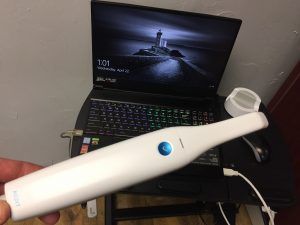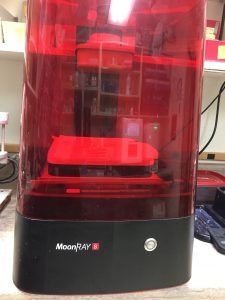Call/Text for A Consultation Today : CALL/TEXT US: 405-632-5561
Crowns and Bridges
What does getting a crown involve?
A crown procedure can be completed in one 2 hour appointment or over two appointments as your schedule allows. Our office uses the latest technology to scan the tooth (without using the gooey stuff), design and fabricate your beautiful tooth-like crown.
While the tooth is numb, the dentist will prepare the tooth by removing any decay and shaping the surface to allow for the placement of the crown.
The digital impression will then be taken with an intraoral scanner as shown below. This scan used in conjunction with our software is used to create a life-like restoration that will be permanently seated the same day.
You will then be given care instructions and encouraged to have regular dental visits to check your new crown.
Milled Crowns
Crowns have been milled from porcelain blocks for decades. Chairside Economical Restorations of Esthetic Ceramic (CEREC®) has revolutionized dental crown procedures. Traditionally, if crowns, onlays, inlays or dental veneers were required to restore damaged teeth, multiple procedures and a great deal of waiting time in-between would be inevitable. Chairside milling creates these ceramic restorations within minutes in the dental office. This means that many treatments can be completed in just a single visit.
Chairside milling is comprised of several computer-assisted design (CAD) tools and a milling machine that creates custom ceramic restorative devices. Chairside milling can benefit almost anyone needing a ceramic restoration.
How can Chairside milling benefit me?
Chairside milling can benefit almost anyone needing a ceramic restoration. Exceptions include patients who have a prior history of breaking ceramic devices and those with a deep bite. Chairside milling devices are proven to last for over 5 years, but recent research indicates that most Chairside milling-created restorations last for more than 10 years.
Additional advantages associated with Chairside milling include:
No temporary restorations
High-quality ceramic products
Minimal invasiveness
Less injections and discomfort
Fewer dental visits
Cost effectiveness
More natural tooth is saved
Long lasting restorations
Biocompatible solutions
What is the Chairside milling system comprised of?
The Chairside milling System is sometimes called a CAD-CAM system. CAD-CAM means Computer Assisted Design and Computer Assisted Milling. The Chairside milling system has three major components:
Acquisition device: intraoral scanner discussed above. It can be used for milled, printed or cast restorations.
Three-dimensional CAD software: This software allows the dentist to examine the tooth from every angle. It is the closest possible thing to holding the tooth in the hands and rotating it.
Milling device: This unit actually manufactures the custom restoration from the specifications entered into the computer. A ceramic block that best resembles the existing tooth color is chosen and placed into the milling unit. Within minutes, the mill produces the restoration the dentist designed.
What does a Chairside milling restoration procedure involve?
The first step in the procedure is preparing the tooth for the restoration. Depending on your particular case, the dentist will take photos of your affected teeth using an intraoral camera or the intraoral scanner for a preoperative 3D representation of the tooth.
These images are transposed onto the computer screen, where the dentist will view the tooth from every angle and design the final restoration. When the design is complete, it will be transmitted to the milling unit.
The dentist will insert a block of ceramic, matching your tooth color, into the milling machine which will then create the full crown, onlay, inlay, or veneer. It will then be placed in an oven to undergo the crystallization process to add strength to the crown. Before affixing the restoration to the tooth, the dentist will perform a dry fit to ensure the margins are perfect and the contact with the adjacent teeth is adequate. Once a perfect fit is established, the restoration will be polished and affixed to the tooth with dental cement.
3D Printed Crowns
Printed crowns work in a similar manner as milled crowns in that they are also scanned and designed using CAD software. Instead of sending the design to the mill, the design is sent to a 3D printer. The printer fabricates the crown from a porcelain resin(https://www.ada.org/publications/cdt/glossary-of-dental-clinical-terms#pp). After the crown is finished printing, the excess resin is cleaned off and the crown is processed in a postprocessor to harden the resin one last time.
Why a printed crown vs milled?
How does this compare to a milled crown that we currently do in office? The printed crown is not as hard as a milled crown. For years dentistry has pursued making crowns harder. But over time these crowns can damage opposing natural teeth by wearing it away. A less hard printed crown can be great for a crown that opposes natural teeth and better matches the hardness of a natural tooth. Of course each crown has its preferred application that your dentist can help you with.
Fixed Dental Prosthesis (Bridge)
A dental bridge is a fixed (non-removable) appliance and is an excellent way to replace missing teeth. A bridge typically consists to two crowns that go over two anchoring teeth (abutment teeth) and are attached to pontics (artificial teeth), filling the gap created by one or more missing teeth.
There are several types of bridges. You and your dentist will discuss the best options for your particular case. The “traditional bridge” is the most popular type and is usually made of porcelain fused to metal. All porcelain fixed bridges are most popular because they resemble your natural teeth with no metal substructure.
Dental bridges are highly durable and will last many years; however, they may need replacement or need to be re-cemented due to normal wear or eating sticky candies.
Reasons for a fixed bridge:
Fill space of missing teeth.
Maintain facial shape.
Prevent remaining teeth from drifting out of position.
Restore chewing and speaking ability.
Restore your smile.
Upgrade from a removable partial denture to a permanent dental appliance.
What does getting a fixed bridge involve?
Getting a bridge usually requires two or more visits. While the teeth are numb, the two anchoring teeth are prepared by removing a portion of enamel to allow room for a crown. Next, a highly accurate scan is made which will be sent to a dental laboratory where the bridge will be fabricated. Some bridges can be milled while you wait. In some cases, a temporary bridge will be made and worn for several weeks until your next appointment.
At the second visit (if needed), your permanent bridge will be carefully checked, adjusted, and cemented to achieve a proper fit. Occasionally your dentist may only temporarily cement the bridge, allowing your teeth and tissue time to get used to the new bridge. The new bridge will be permanently cemented at a later time.

Why Progressive Dental?
- Quality crowns and bridges
- Gentle approach to oral care
- Flexible scheduling options
- Online registration forms
- Emergency dentistry services available
Why Crowns and Bridges?
Crowns and bridges help to strengthen weakened teeth as well as defend against any further damage, which aids in better long-term health for you. We have a variety of materials that we can work with to provide you with the perfect crown or bridge that will match your natural teeth color and shape.



